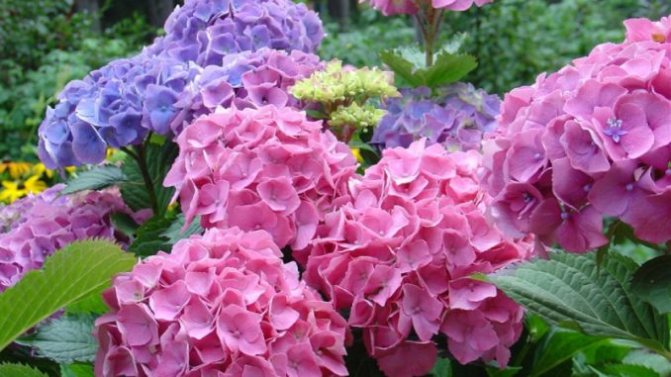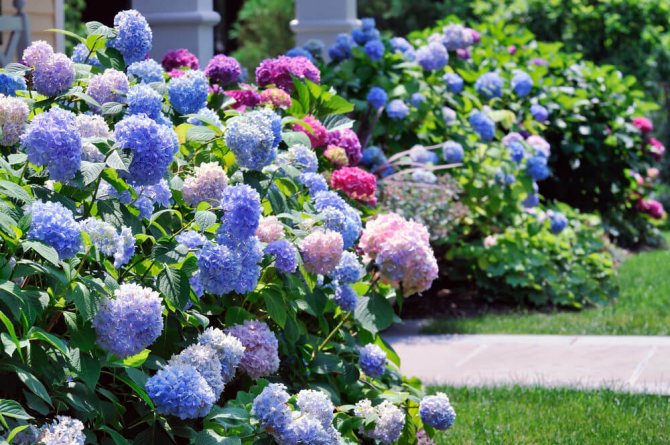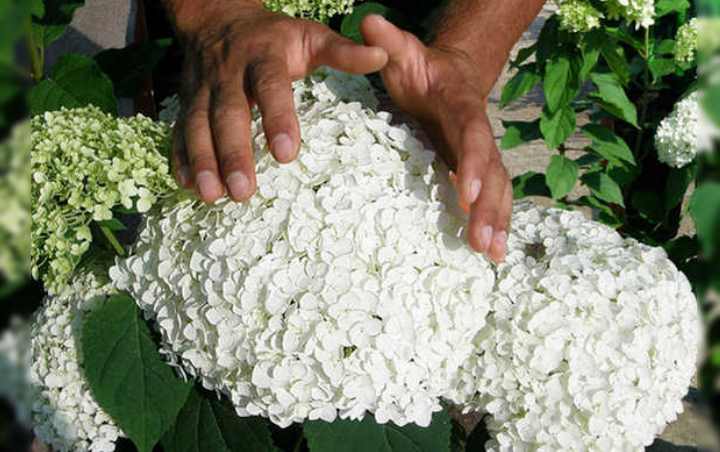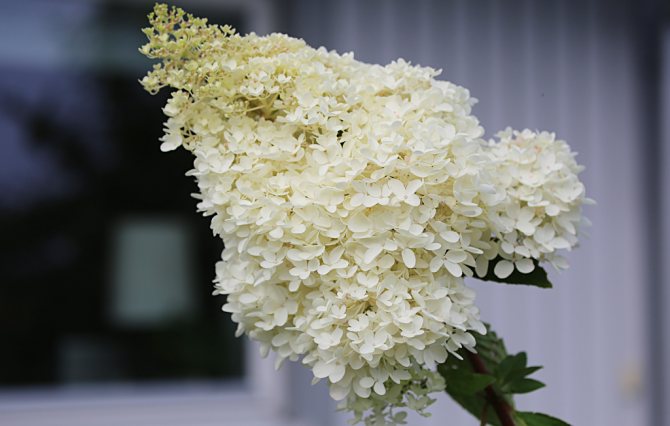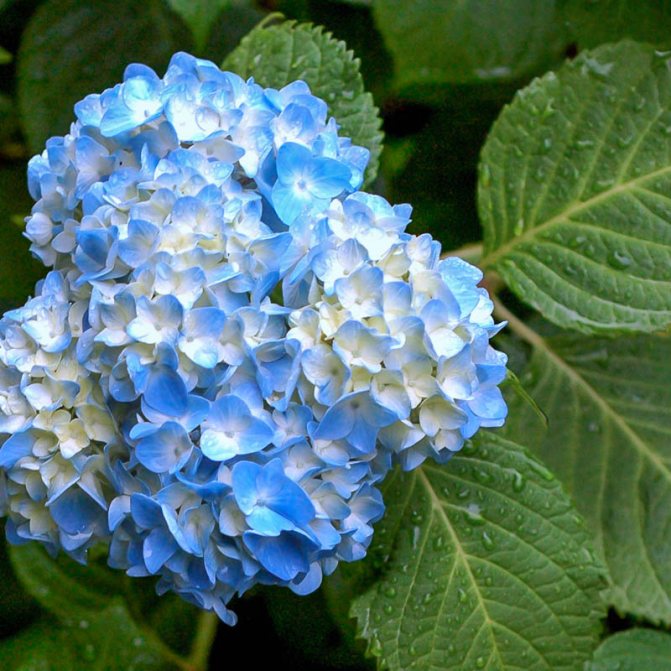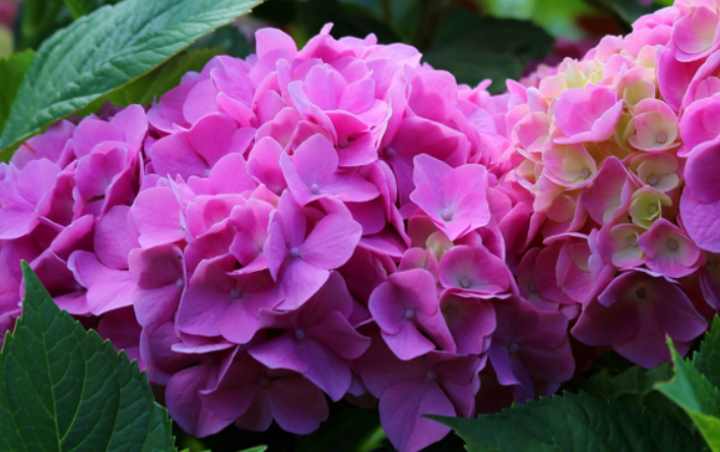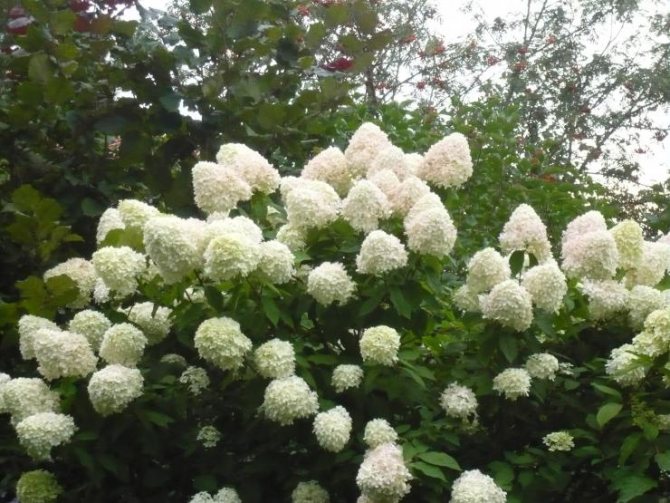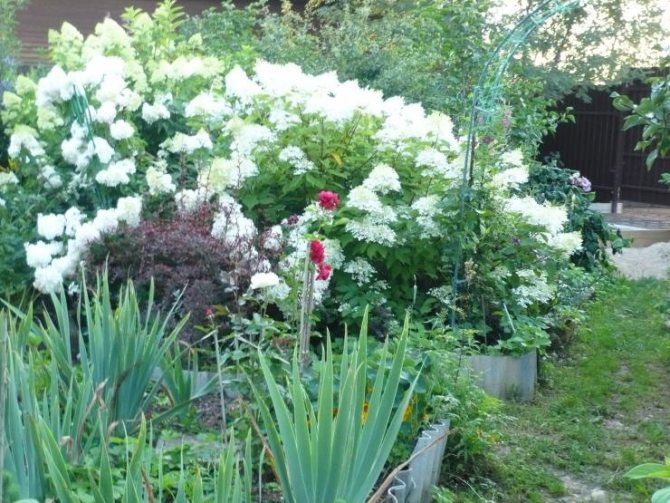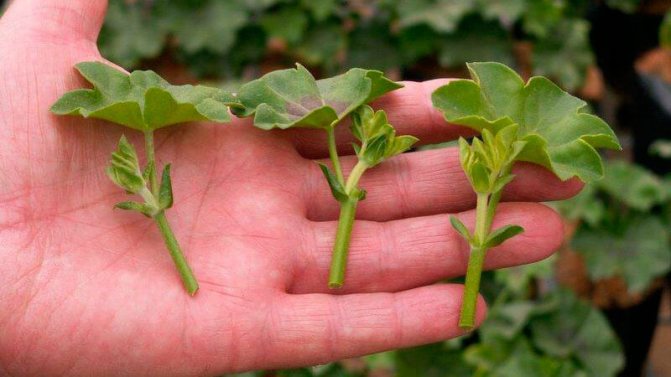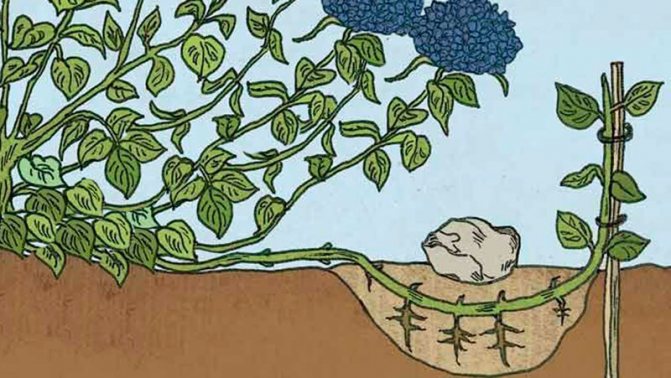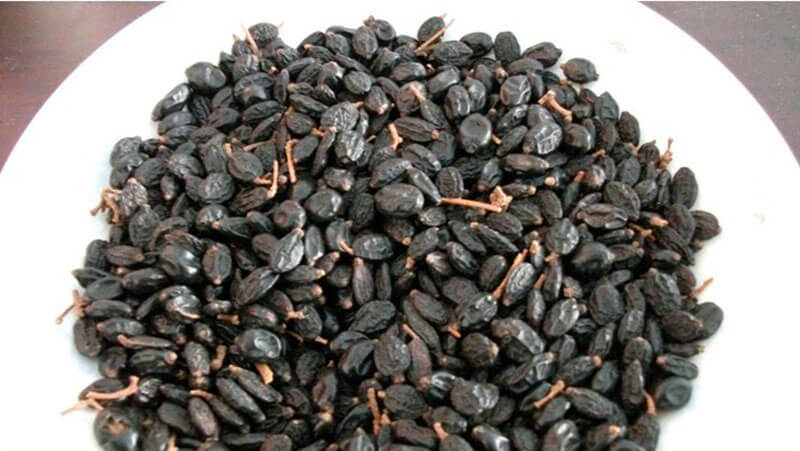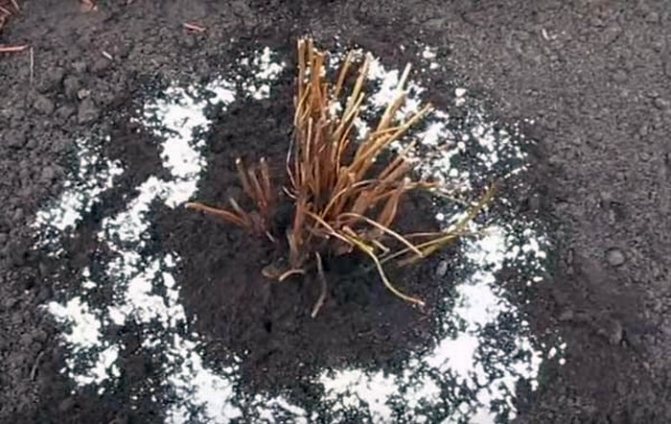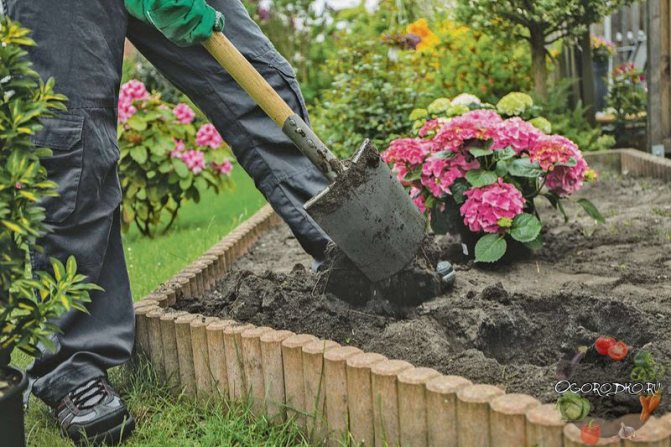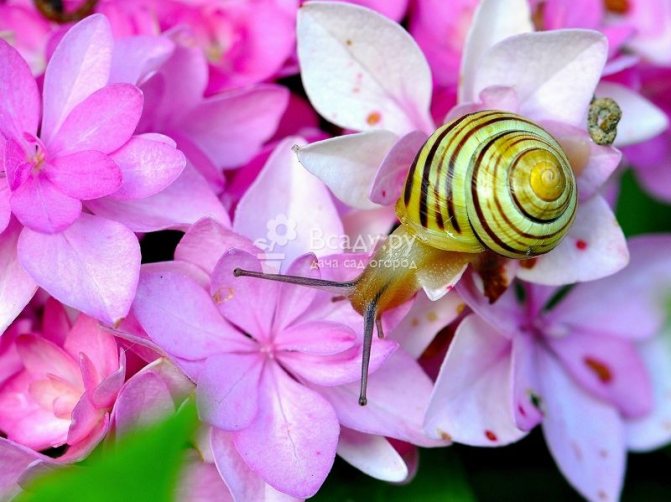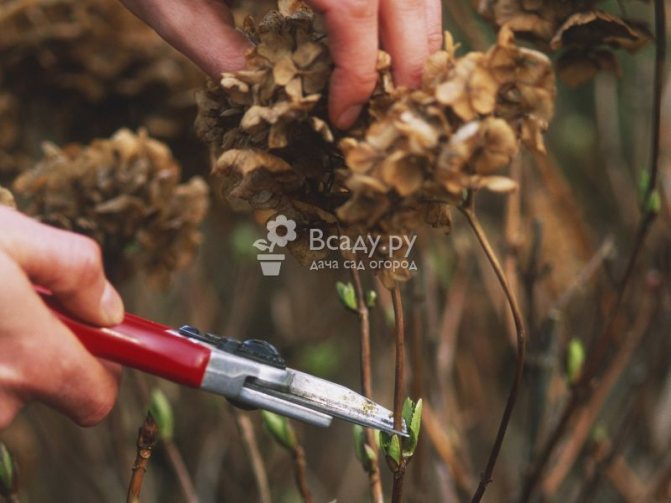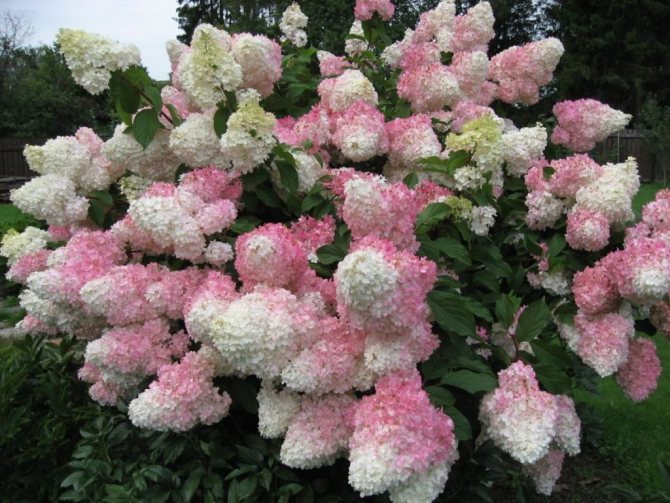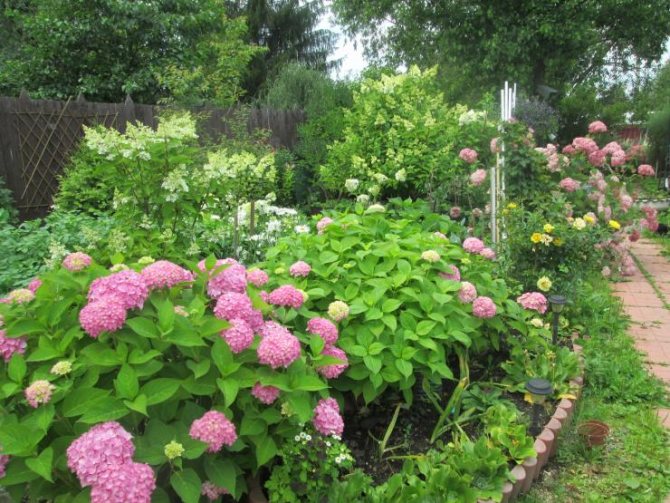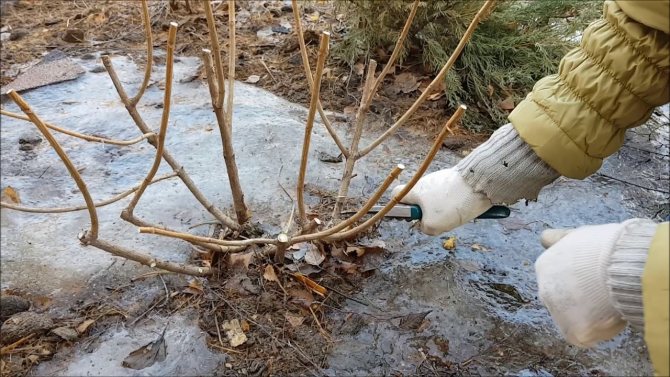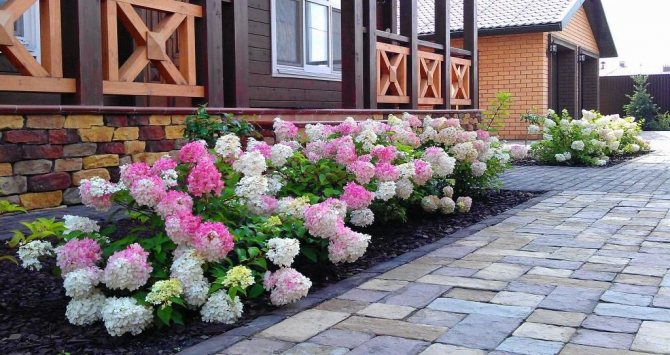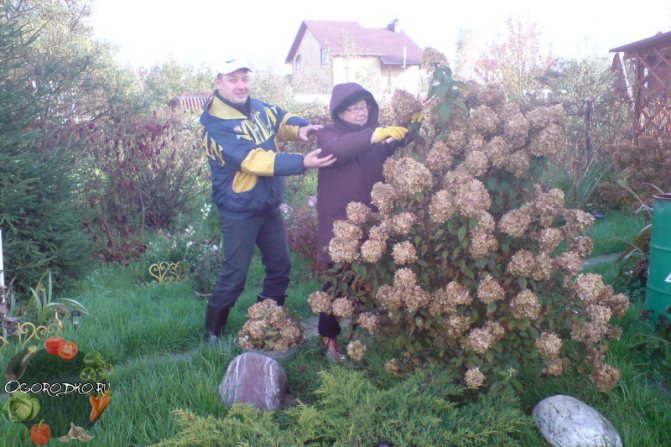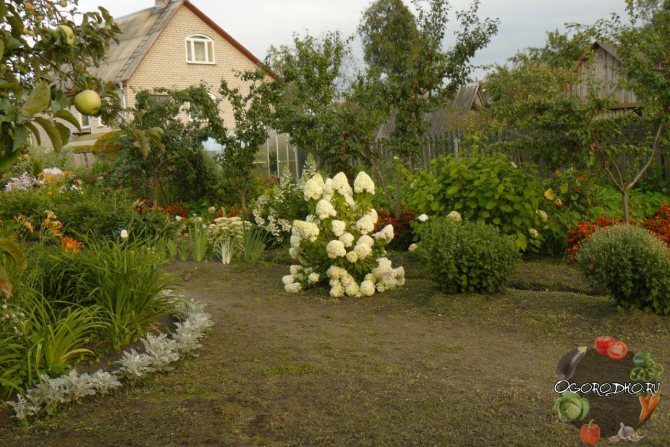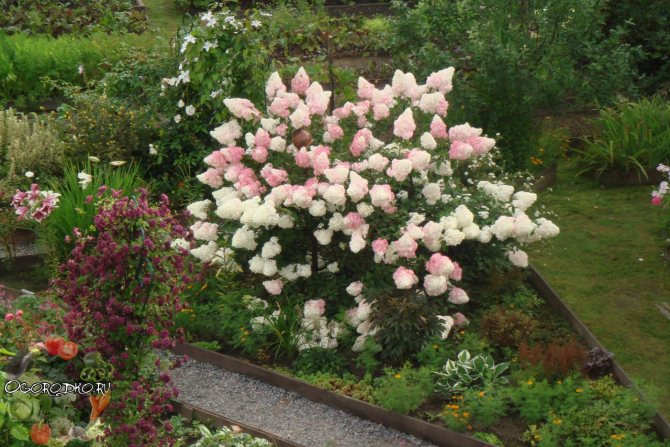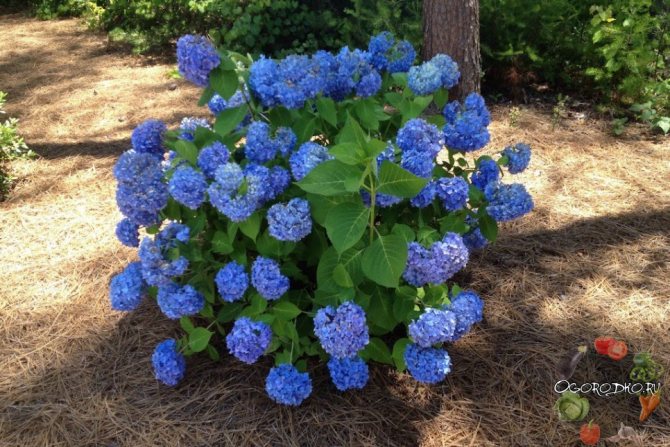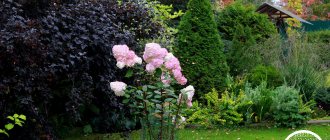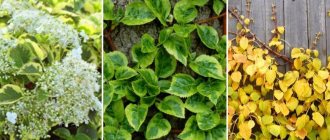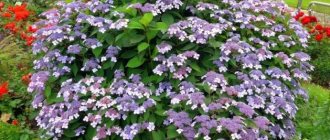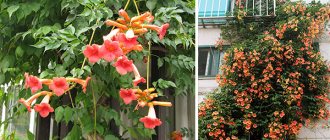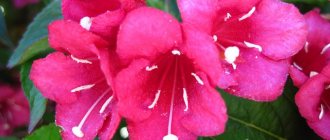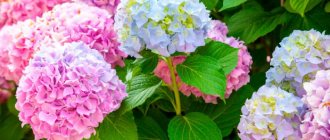Hydrangea is an amazing plant, a bright green shrub with large inflorescences of multi-colored shades (pink, blue, lilac). The shrub grows up to 1.5-3 meters in height, loves water, moist air and coolness. Most often grown in the garden, but home cultivation also takes place.
The main types of hydrangea are: tree, oak-leaved, large-leaved, paniculate, serrate, petiolate, Sargent and Bretschneider. Each type of plant includes several varieties that are unique in their own way; in total, more than 50 species of hydrangea are known.
Hydrangea
Plant species
Today in the world of gardening there are a lot of types of hydrangeas. The most common among them is the large-leaved variety - this plant is picky, but unable to withstand severe frosts. Its flowers can be colored in a variety of colors that the plant shows in the summer. The height of an adult shrub of this variety reaches two meters.
The petioled hydrangea is no less popular. This plant resembles a liana in its appearance, due to which it is often used to decorate arches and garden structures. It is appropriate to plant it near high supports, otherwise the plant will creep along the ground. The inflorescences of this garden hydrangea have a delicate white-pink color that attracts the attention of many lovers.
Another common type of hydrangea is treelike. The bush of this plant can reach up to 3 meters in height, due to which it looks very impressive during the flowering period. White garden hydrangea, as it is often called by plant fans, has large flower stalks that resemble huge caps in their appearance. This variety is especially unpretentious to care for. Moreover, this is a frost-resistant garden hydrangea, preparation for the winter of this shrub is carried out without any problems.
Another common type of hydrangea is panicle. This plant pleases the eye with its unique inflorescences, presented in the form of both small and large panicles, the length of which can sometimes reach 30 cm. These varieties are distinguished by their frost resistance and unpretentious care. As for the variety of shades, the color of the inflorescences can vary from snow-white to greenish.

Hydrangea: species and varieties. Photo and description
East Asia is the birthplace of hydrangea. In the wild, hydrangeas can be found in America in both hemispheres. Hydrangea was introduced to European countries at the beginning of the fourteenth century. England and France immediately appreciated all its merits.
According to one version, the flower took its name from the Latin language, in particular from the word hortus-garden. According to another version, the name came from Princess Hortense, the sister of Emperor Charles. The Latin name Hidrangea, hydrangea received for its moisture-loving nature. And translated into Russian it means a vessel filled with water.
Hydrangea has more than 70 species:
- tree-like,
- paniculate,
- large-leaved,
- rejected,
- oak-leaved,
- petiolate
- and even a ground cover.
In Russia, flower lovers grow tree and panicle hydrangea... Little by little, garden plots began to conquer large-leaved and petiolate hydrangeas.
The simplest and most low-maintenance - tree hydrangea. It's hard to say where this name came from. Its branches are not at all like tree trunks. All branches grow from the ground. This hydrangea does not need shelter, it grows and blooms on the shoots of the current year.
- Variety Annabelle, which is most famous, probably grows in every flower lover in her garden. The variety is over 200 years old. It was bred in the USA in the village of Anna, from which it got its name. There the bushes reach 5 meters. Our bushes are 1.5 m high, up to 3 m in diameter. Greenish-white thyroid inflorescences, up to 25 cm in diameter, do not change their color during the season. The color of the inflorescences cannot be changed by changing the acidity of the soil. Many years ago, when planting, we, not knowing anything about the hydrangea, buried nails under the bush. But, of course, no color change was achieved. The shrub is fast-growing, frost-resistant, withstands frosts up to 40 degrees.
- Incredible considered the best variety. Its beautiful inflorescences have a diameter of as much as thirty centimeters. At first they are lemon, but gradually turn white. Its foliage is matte green. The bush reaches a height of one and a half meters.
- Variety Invisible spirit ideal for the Moscow region due to its amazing winter hardiness. So the translation of its name from English "invincible spirit" accurately reflects its unpretentiousness and resistance to frost. The bushes of this variety are small in themselves, they reach no more than a meter in height. Inflorescences, very sophisticated dark pink, thirty centimeters in diameter.
- Pink Annabelle and Bella Anna, these varieties also change their color. First they are white and then pink. But according to some sources, pink lasts no more than a week. Whether this is true or not, I do not know, but I will not risk it.
Only the classic Annabelle variety grows in my garden. And it seems to me that one voluminous bush of a tree hydrangea is quite enough for an ordinary summer cottage.
My heart is given panicle hydrangea... It could also be called tree-like because its trunks are like small trees. But it got its name from the shape of the inflorescences that resemble panicles. Many varieties of panicle hydrangea differ in height, from dwarfs to giants, in the shape of inflorescences from dense spike to light openwork, in the type of flowers.
Their colors are varied: white, pink, red, changing with the season. Moreover, they also grow on the shoots of the current year. They are unpretentious in leaving. Resistant to frost. You don't need to cover them.
- Variety polar bear no wonder it has such a name. This large bear reaches a height of up to two meters, and its inflorescences reach up to 45 cm in length. By autumn, its creamy flowers change color to pink.
- Variety Phantom... Even higher, up to three meters. Does not bend from the wind. It was not for nothing that they called it a "phantom". Striking with bright white giant dense inflorescences, which by September become pink with a delicate tint with an amazing aroma
- Variety Bobo it is considered a dwarf variety, it is not higher than 80 cm. A strong bush that does not require a garter with lacy airy inflorescences. Inflorescences closer to autumn change their color, and from white they turn soft pink, similar to vanilla ice cream
- Have Pinky Winky varieties inflorescences with sharp tips, similar to a mouse's tail. Will definitely put in this 2020 year. Since this year is the year of the mouse. Also, this variety changes its color. From white, its inflorescences gradually turn crimson.
- Great Star - this is a high grade, up to two meters. Its flowers look like helicopters, with a wonderful aroma.
- Variety Earle Sensation even taller, blond, handsome, up to two and a half meters in height. It blooms in late June with white flowers, which then turn soft pink and crimson in September. This is a real "early sensation". At the same time on the bush inflorescences are white, pink and crimson. An amazing scent completes the charm of this hydrangea.
I talked about the varieties that I liked. But each variety of panicle hydrangea is beautiful in its own way. The head is dizzy from the variety of varieties. And all are suitable for our region. It is simply impossible to make a choice.
The first place in beauty among hydrangeas rightfully takes Sadovaya or large-leaved hydrangea... It has large, large, textured leaves. Hence its name. It prefers only acidic soil, grows on shoots of past years and necessarily requires shelter. This variety blooms in the second year. Frost resistance is increasing every year.
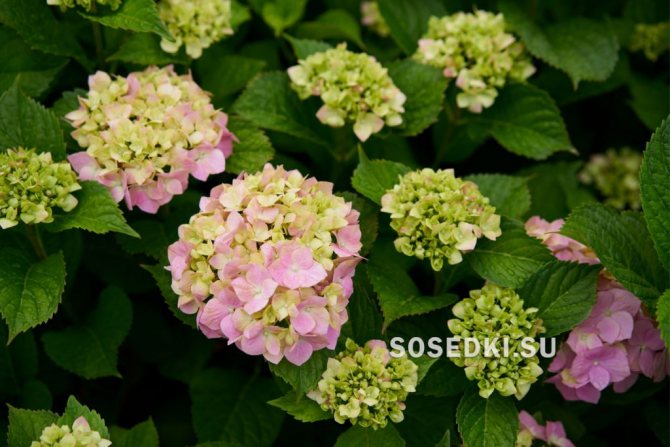

Large-leaved hydrangea in the garden
They make a shelter above it, depending on the weather in October-November, with spruce branches, then put a frame, a box can be placed, covered with two layers of lutrosil.
- Cover with a sheet of slate on top. Instead of slate, you can cover the lutrosil with a film, but without fixing it on both sides, so that there is air access. The main thing is that you cannot cover the hydrangea early as it can withstand temperatures of -5 degrees in autumn.
- But in spring it is impossible to remove the shelter early, as with late spring frosts at a temperature of -5 degrees, the bushes can freeze.
- It is necessary to remove the shelter gradually, the main shelter in May, when the threat of frost has passed. But even under a difficult cover, the bushes may freeze and not bloom.
Therefore, some gardeners plant a garden hydrangea, already growing in pots, and when cold weather comes, they water it abundantly and store it in the basement until spring. Most garden hydrangeas are very difficult to grow on their own plots. Previously, only gardeners from warm southern regions could boast of beautiful flowers.
But, finally, in 2003, winter-hardy varieties were bred - a series of varieties Endless Summer. Large-leaved hydrangea Endless summer “blooms on the shoots of previous years” and “on the shoots of the current year”. Thus, if some of the shoots freeze, the hydrangea will still bloom. This hydrangea blooms most of the summer. It fades and re-ties the buds.
Garden hydrangea is the only hydrangea that changes color depending on the pH of the soil. On more acidic soils, the inflorescences turn blue, blue, purple. On alkaline - pink and red. There are special fertilizers for blue or red hydrangeas. By adding them to the soil, we change the acidity of the soil and achieve the desired color. But since hydrangeas like acidic soils, you should not especially abuse fertilizers to increase the alkalinity of the soil.
Petiolate hydrangea - This is a liana, reaching 3 m. It blooms in June-July with pinkish-white flowers. She does not need to be covered and cut off, but for some reason I have never met her on the plots.
How to plant
It should be noted that the process of planting the shrub under consideration in open ground is quite simple and does not require special skills from the gardener. In order for the plant to feel as comfortable as possible, it is necessary to choose the right place for it. The ideal option for planting cuttings will be the sunny side, where prolonged shading will not be observed.
As for the disembarkation period, it is also of no small importance. So, this process is best done during the warm spring or autumn months (May or September).
As for the process of immersing the cuttings rhizomes in the ground, for this you need to first dig a small hole, the depth and width of which will reach 50-60 cm.
At the bottom of the formed hole, it is necessary to lay out a special mixture necessary to improve the process of plant growth, as well as fertilizer (we will talk about what should be in the composition of these components later). After that, you need to immerse the cutting there. When planting a plant, it should be borne in mind that its root collar should be located at soil level.
At the final stage of planting, the shrub must be watered abundantly so that the roots are saturated with a sufficient amount of moisture. Only in this way will they take the necessary strength and rather quickly enter the phase of active growth and development after the initial leaving and planting.
Garden hydrangea has some requirements for its placement in the soil. In order for the plant to feel comfortable, during planting it is necessary to leave a certain distance between the bushes - about 1.5 meters. So, they will be able to grow correctly, without interfering with each other, and will also look quite impressive and bright, delighting the guests of the garden with their powerful and abundant flowering.
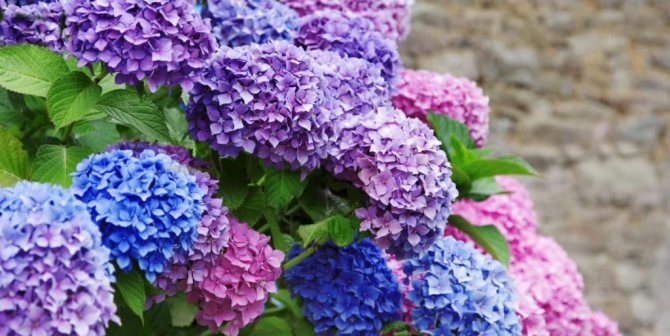

FEATURES OF LANDING, TRANSPLANTING AND REPRODUCTION OF HORTENSIA
Hydrangea tolerates well both autumn and spring plantings, especially if the seedlings are with a closed root system. But in the fall, it is recommended to carry out this operation no later than September 15, so that the young bushes have time to take root well and prepare for winter.
It is also possible to transplant a hydrangea (entirely from one place to another) during these periods. But this should be done only as a last resort, because it is difficult for this plant to take root in a new place.
But when it comes to reproduction, be very careful here!
In spring and autumn, hydrangea can be propagated by layering, in summer by cuttings, and dividing the bush - only in the spring!
Many gardeners believe that all perennials should be planted only in late summer - August, early September. And they try to propagate hydrangeas in this way, digging up the bushes, disassembling them into pieces and planting them in new places.
Remember that 80 percent of them will not take root in you and will die. In the fall, hydrangeas can be propagated by division only in the southern regions.
Hydrangea reproduces well when dividing the bush in early spring - until the buds swell, as soon as the snow melts and the earth thaws. The best time for this is late April - early May.
We told you how to grow hydrangeas in the summer-autumn period. Now you can surely get some stunningly beautiful flowering shrubs. It remains only to choose the varieties.


The composition of the bookmark when landing
As noted above, for the accelerated growth of a plant, it must be fertilized at the time of planting. To do this, before immersing the cutting into the hole, it is necessary to put in useful components, among which there must be a mass of substances intended to strengthen the plant, as well as fertilizers.
What does a garden hydrangea require for its strengthening and early rooting? The composition of the mixture that has a direct effect on these processes should include soil with humus, as well as sand and peat, taken in proportions of 2: 2: 1: 1.
Speaking of fertilizers, it should be noted that hydrangea is a rather picky plant towards them. As noted by most specialists in the field of landscape design, in order for the shrub to absorb the largest amount of useful components, due to which it grows quickly and blooms profusely, superphosphates in the form of granules (60 g), humus (10 kg), potassium sulfide, as well as urea (20 g).
When planting a plant, you must pay attention to the fact that the garden hydrangea does not tolerate staying in calcareous soil disgustingly. That is why you should completely exclude the ingress of lime into the ground.
Landing rules
The time when and how to plant hydrangea is chosen based on the climate of the region. It is best to do this in the spring, so that the seedling has time to take root before the fall and survive the winter well. You can plant new plants in the fall, but pick up the time before the first frost. Rooting lasts 1 - 1.5 months.
When planting hydrangeas, the acidity of the soil and the location relative to the sun's rays are taken into account - in an open place, the flowers dry out and die faster.


Soil requirements
An acidic soil pH is one of the basic conditions for growing hydrangea bushes and making them bloom regularly. This species poorly assimilates nutrients from the soil, which contains a lot of carbonates - carbonic acid salts. The tree variety adapts better, but its decorative effect can also deteriorate, so the soil for the hydrangea should be in the range from 4 to 5 pH units.
So that when caring for a hydrangea in the first year of planting, the plant does not weaken due to a lack of nutrients associated with the quality of the soil, it must be prepared in advance. For this, high-moor peat is used - it is loose, sour and nutritious. Several tasks are being solved at the same time:
- Attracting soil bacteria and earthworms that produce humus.
- Stimulating the root system to grow.
- Loosening the soil to improve aeration of the root system.
You can maintain acidity with fertilizers - superphosphate, potassium sulfate and ammonium. To change the color of the pink hydrangea to blue or blue, an additional additive is added - aluminum sulfate.
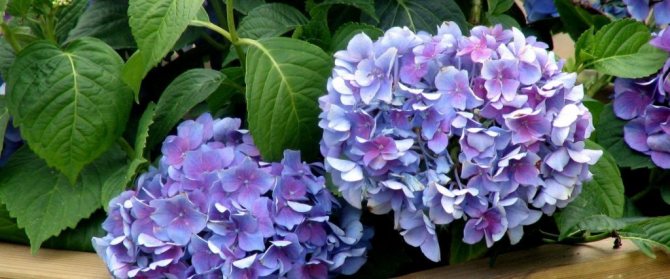

Organic, which hydrangea also loves, is a source of humic acids. You can use it every 2 years for soil restoration. This is done in the fall so that microorganisms have time to transfer nutrients into a form that is easily digestible for plants.
Seat selection
To plant hydrangeas, you need to select a place with the following calculation:
- So that the place is under the sun in the morning and in the evening, and during the day the bush remains in the shade.
- The groundwater did not come close to the soil surface and did not flood the roots.
- Crops did not grow nearby, the root system of which is in the same soil horizon. This provokes a struggle for nutrients between plants.
It is important that the bush is protected from wind and drafts - decorative species do not tolerate them and react with poor flowering.
Another important point on how to plant and care for hydrangea: during flowering, the bush sometimes splits to the sides due to heavy peduncles. If it is planted close to a footpath, then after a rainstorm it can completely block it. Given the height of the shoots, you need to retreat from the edge of the path at least one meter.
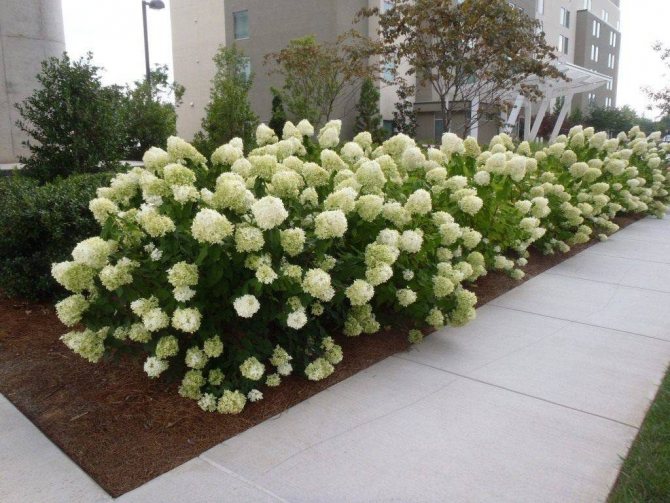

In a decorative plan, shrubs during flowering look good against the background of green thuja or ivy covering the fence, the wall of the house. Group plantings are available over a large area, as the distance between the hydrangeas takes into account future growth maintained 1 - 1.5 m.
It is necessary to remember if organic fertilizers such as wood ash, lime or chalk were applied to the site. This procedure is sometimes carried out to deoxidize the soil for plants that need a neutral or slightly acidic environment.
If the garden bed intended for planting hydrangeas has undergone such treatment, the shrubs will develop poorly and may die in the first year of life due to the inadequacy of the acidity of the soil to the nutritional needs of the plants.
Transplant procedure
Some points of how to plant a hydrangea depend on the age of the seedlings. The roots of the plant are very branched and are always larger than the aerial part. When transplanting, it is important to damage them less, then rooting is successful.
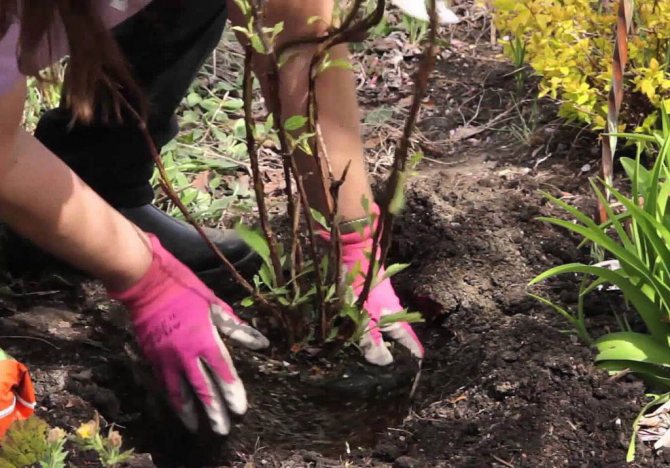

At the time of buying biennial bushes the depth of the pit can be 30 by 30 cm, for adults 4 - 5 summer crops it is increased up to 50 - 60 cm. Trees over 7 years old dug out together with an earthen clod and transferred to a hole the size of a little over a meter. This procedure is rarely required, since hydrangeas grow in one place. up to 40 years old.
Planting hydrangeas and care step by step:
- A pit is being prepared with a width greater than the diameter of the roots. Do it a couple of weeks before the intended landing.
- The bush itself is desirable 2 - 3 days drink plenty of water or put for 5 - 6 hours in warm soft rainwater - the roots quickly absorb it. It is important not to deepen the root collar.
- Heavy soil is mixed with peat, sand, adding small stones for drainage. A layer of broken brick or medium-sized river stones is laid on the bottom. Granular fertilizers superphosphate and potassium sulphide are added to the soil mixture - this will give nutrition to the plant for the first 2 years.
- The bush is removed from the pot and placed in a pit. It is important that the root neck is at the same level, you cannot sprinkle it - rot is formed.
- Sprinkle the soil on the sides and tamp it down, pouring a little rainwater over it.
If there is a coniferous forest nearby, needles and crushed cones are mixed into the planting soil. They have a high acidity and are well suited for hydrangeas.
General care information
Planting hydrangeas in the open field, as well as the subsequent care of it, does not have any difficulties. As noted by many gardeners, it is feasible even for individuals who are starting to reproduce flowers.
When growing a hydrangea on your site, you must definitely pay your attention to watering the plant. It should be moderate and, moreover, its root system should not need moisture, otherwise the hydrangea foliage quickly becomes lethargic and loses its presentable appearance. In order to ensure constant moisture in the soil in which the plant is planted, many gardeners recommend mulching the shrub with sawdust or peat in the spring - these components help protect the topsoil from the sun's rays, as well as from drying out.
Studying the features of growing hydrangeas in the open ground and caring for the plant, you need to pay attention to the fact that the shrub needs oxygen to enter the area of the root system. As you know, this can only be achieved by maintaining constant looseness of the soil, as well as by regularly cleaning it from weeds.
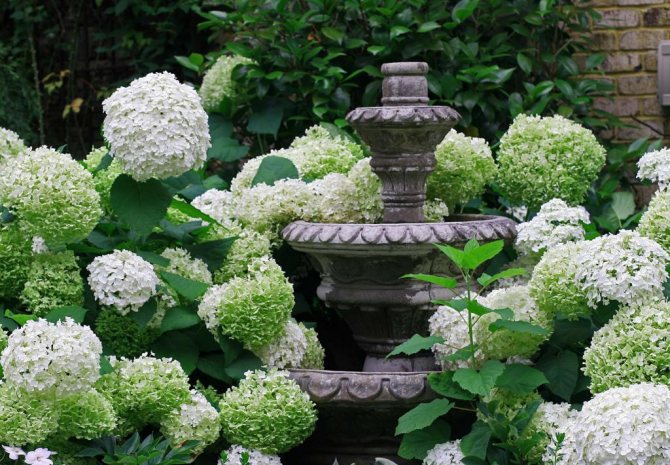

How to plant a hydrangea in the open ground in spring
Planting hydrangeas outdoors in spring
Step-by-step guide to transplant seedlings:
- How to grow hydrangea in the garden? Having chosen the most suitable place for planting flowers, it is worth starting to prepare the planting pits.
- Fertilizers should be added to the dug holes.
- Spread the roots of the seedlings and deepen into the planting holes.
- Fill the resulting voids in the recess with a soil mixture. Cover the roots with soil so that it slightly covers the root collar. Deeper deepening provokes rotting of the root system.
- Tamp the soil surface in the planting zone.
- Moisten the soil abundantly and evenly.
- Mulch the area of the trunk circle with a layer of pine bark, sawdust or peat. Mulching makes it possible to maintain moisture for a long time and slightly acidify the soil. For additional acidification of the earth, you can scatter a couple of tablespoons of colloidal sulfur over the hole covered with soil.
- Cut off the tops of the bushes, which will make it easier for the bushes to take root in a new place. Sprinkle the hemp obtained after cutting with a small amount of mulch.
Note! When planting several seedlings in one area, it is important to observe the distance between the planting pits within 100-120 cm.
Pruning
The peculiarity of caring for hydrangea also lies in the fact that this shrub needs regular and correct pruning. In the recommendations of specialists, it is noted that this process should be carried out exclusively in spring, for a certain period before the start of the growing season. In the process of pruning, it is necessary to remove old branches, leaving only young shoots. It should be noted that young branches also need to be shortened a little, cutting off 3-4 buds at a time.
Pruning garden hydrangeas is contraindicated in the fall. The only exceptions are those cases when it is necessary to remove wilting inflorescences. It is imperative to cut off old flowers, as they nourish the strength of the plant, preventing new buds from developing fully.
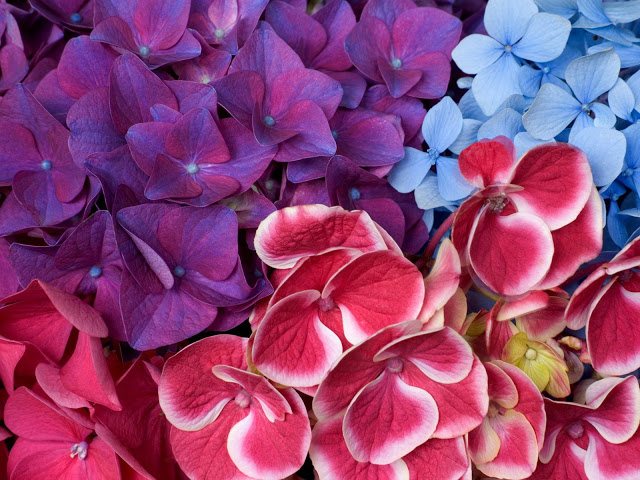

Pruning hydrangea
I do sanitary pruning of hydrangeas, regardless of the species, in the spring.
- I remove thin, broken, inward-facing branches that cross and interfere with each other, leaving stronger ones.
- At the same time, I do a rejuvenating pruning, removing very old branches at ground level.
- As in all other bushes, I cover the finger cuts with garden pitch.
I cut the inflorescences in the fall so that the branches do not break under the weight of the snow-covered inflorescences. You can leave the pruning until spring, as in winter bushes with inflorescences, covered with snow, create a fairytale atmosphere.
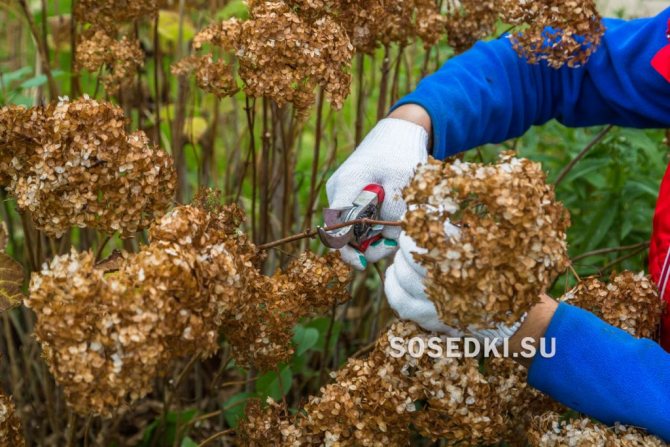

Tree hydrangea you can not cut it, just thin out too thick bushes. But then its decorativeness falls, the inflorescences become smaller, long branches break under the weight of flowers. To obtain large inflorescences, formative pruning is needed.
I prun the hydrangea every spring after the buds have swollen, at the beginning of May I make the branches of different lengths.
- I cut off old branches to 10 cm.
- The rest are up to 4-5 buds from the ground.
- Some only shorten to the first strong bud from the top of the bush. It seems to me that this increases the decorative effect of the shrub. Flowering will be early, the bush is lush, although the inflorescences are smaller.
Panicle hydrangea I prune every spring, shortening all the shoots by 15 cm. In addition, I form skeletal branches so that each strong branch has no more than two branches. I shape it like a tree. Many people prune the panicle hydrangea for 1-2 buds. But I want to see a powerful bush, and since we may not have summer, I'm afraid that the hydrangea will not have time to grow and bloom. The only thing that seems to me to be done is, after the buds begin to grow, pluck out the extra young shoots that thicken the bush.
Have garden hydrangea flower buds are located at the top, at the ends of the shoots, so it is not cut off. Do only sanitary pruning, removing broken and frozen shoots.
You can also read this article on how to prune roses in your garden.
Top dressing
In the process of growing hydrangeas, an important issue is the topic of feeding the shrub. It should be noted that the commission of this type of action is not necessary in the first couple of years following the planting of the plant in open ground. During this period, the young bush will feed on those fertilizers that were laid in the hole during its placement in it.
After two years, feeding the plant is a must. Moreover, it must be performed in strict accordance with a certain algorithm. The beginning of the annual feeding of the shrub must be carried out in early spring, when budding is just taking place and the overwintered cutting enters the active growth phase. At this time, it is important to apply complex fertilizers consisting of potassium, nitrogen and phosphorus, which are present in most formulations offered in gardening stores.
The second stage of plant feeding should take place during the period when the first peduncles appear on the branches. At such a time, a mixture consisting of superphosphate and potassium sulfate must be introduced into the ground - the ingredients must be combined in equal proportions.
After the plant enters the phase of abundant flowering, the soil under it should be fertilized with chicken droppings or cow dung. Fertilizing the shrub with the indicated components, it should be remembered that their amount should be small, otherwise the leaves of the plant will begin to turn yellow and fall off. Moreover, excess droppings can lead to poor overwintering of shrubs.
Garden hydrangea is a plant that responds positively to the introduction of lactic acid under it. Its content is found in milk whey, kefir, as well as in soaked bread.
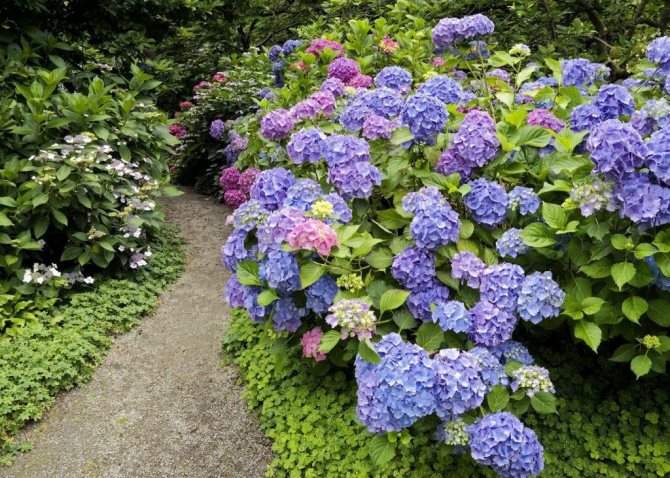

Preparing and sheltering hydrangeas for the winter
The culture has a superficial root system that is prone to freezing. In the fall, it is necessary to prepare a flower garden for wintering. The bushes should be huddled high and well mulched.
In October, you need to take care of a winter shelter. Young bushes are bent to the ground, and covered with roofing material, pressing the edges of the sheet with stones or bricks.
Adult bushes are tied up and wrapped in spunbond. Around them, frames are constructed from a mesh in the form of cones. The space between the net and the shelter is filled with dry leaves.


Shelter hydrangea for the winter
Reproduction and care
Planting a perennial bush hydrangea in the process of its reproduction has some features. As in most cases, this plant propagates exclusively in a vegetative way, by cuttings and dividing the bush.
The planting process of the bush must be done in the spring. When choosing elements for separation, you need to pay attention to the presence of a sufficient number of buds on the branches - there should be at least 2-3.
If the gardener decides to reproduce by cuttings, then it is better for him to start this process in June. To do this, you should cut off the non-lignified tops of the shrub and plant them in peat soil mixed with a small amount of sand. Until the roots are formed, an increased level of moisture in the soil should be maintained, for which sphagnum moss can be added to the soil. As practice shows, when sufficient moisture is created and the soil is correctly selected, the rooting of the plant occurs within 4–5 weeks, after which it can be planted in open ground.


Reproduction by root suckers
You can grow a hydrangea from seeds by dividing the bush and cuttings. The plant reproduces very well by root suckers. Offspring, or shoots, is a young shoot extending from the root, which, during growth, forms its own root system.
Important! Depending on the bush, many offspring may form on the plant, or, conversely, none, so you need to carefully monitor the hydrangea and, in the presence of powerful offspring, carry out the planting procedure.
The offspring, along with the resulting roots, are carefully dug out without harming the mother bush. They are transplanted to another place and take care of it as a full-fledged plant.
Preparing for winter
It should be noted that throughout the summer, the hydrangea looks like a real queen of the garden, decorating the entire territory with its abundant flowering. However, after summer, there comes a period when it is necessary to properly prepare the shrub for wintering. Consider further the main features of care in the fall.
Garden hydrangea in the autumn period requires compliance with special irrigation conditions, which provide for the maintenance of a normal level of soil moisture under it. The volume of water should be drastically reduced when the average daytime temperature begins to fall below +7 degrees, and at a time when the thermometer is in the region of 0, soil moistening should be stopped altogether. When preparing a garden hydrangea for winter, you should also pay attention to the weather: if it is rainy, then there should be no intentional additional moisture in the soil.
In the autumn season, the root system needs special nutrition. At this time, phosphorus-potassium fertilizers should be applied to the soil. This is the main feature of care in the fall.
Outdoor garden hydrangea needs periodic cosmetic pruning. In autumn, the gardener must very carefully remove dried shoots, as well as the remnants of inflorescences, without touching the main parts of healthy stems. Pruning garden hydrangeas during this period should be especially gentle. It should be carried out with the most well-sharpened tool.
Hydrangea in the garden
Hydrangea in the garden is an incredibly beautiful and delicate plant, and like everyone else, it needs care and attention. In order for the hydrangea to fully grow and bloom on time, the care must be correct, it is necessary to provide the plant with:
- acidic moisture-consuming soil;
- semi-shaded area;
- abundant systematic watering;
- competent timely pruning;
- preparation for wintering.
In the garden, the hydrangea is provided with a suitable site, depending on the variety:
- paniculate varieties are distinguished by fragile shoots, in order to protect them from snow falling from the roofs, they are placed icicles away from buildings;
- petiole varieties require support, so it is convenient to plant them near the walls of a garden house, fences, gazebos;
- most of the varieties prefer free places with openwork penumbra.
About pests
The main danger to any outdoor hydrangea is leaf aphid. In more rare cases, a false spider mite settles on shrubs, and this plant can also become infected with chlorosis and powdery mildew.
As practice shows, pests appear on shrubs due to the fact that there is a lime content in the soil where they grow. In order to eliminate the problem, every three days the plant must be watered with solutions with the addition of potassium nitrate.
As for aphids, you can get rid of this pest by treating the plant with garlic infusion. In order to cook it, you need to take a bucket of water and pour 200 g of crushed garlic into it. The mass should be allowed to brew for a couple of days, and then little by little irrigate the bush with it until the pest is exterminated.
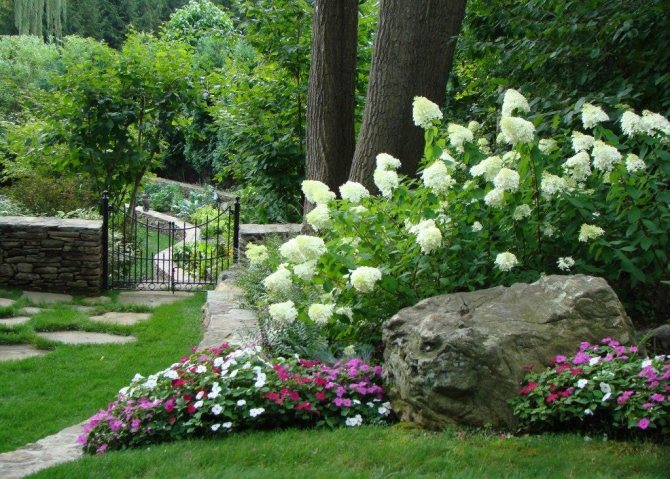

Protection of hydrangeas from diseases and pests
Spring treatment of the plant and the soil under it with Bordeaux liquid and ferrous sulfate is necessary for the prevention of infectious diseases. In case of infection, damaged shoots must be removed immediately.
The preparation Rovral Flo 255 SC will help against gray rot. In case of chlorosis, they are sprayed with iron-containing agents. In the fight against septoria - Profit. When rust appears on the leaves, it is necessary to spray the plant with copper-containing compounds - Topaz, Falcon.
Fufan and Tiofos preparations will help against aphids and ticks.
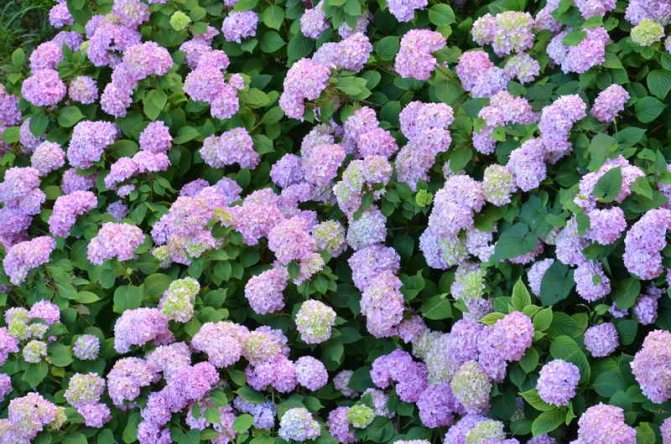

Combination with other plants
The peculiarity of the garden hydrangea is that it goes well both with its congeners and with other deciduous, flowering and even conifers. These luxurious shrubs look especially harmonious with sheared barberries, daylilies, as well as low-growing junipers. When planning a landscape design in which paniculate hydrangea will be present, you should pay attention to the viburnum bladder, as well as purple-leaved barberries.
This luxurious plant should be planted in the background. So it will not shade other plants, and will also act as a bright and very beautiful background. Varieties that grow as small shrubs can be planted along garden paths and as hedges.
Description of the plant
Hydrangea is a perennial flowering plant. Shrubs are most often grown in the garden, which can reach a height of 1 to 3 m and about 1 m in width. However, in the wild, there are types of hydrangeas such as vines and even trees that grow up to 30 m in height. The plant may be evergreen, but taking into account the Russian climate, only deciduous varieties of shrubs are grown in our country.
In their natural environment, they grow in a mild continental and subtropical climate. This is found in the countries of East and South Asia, South and North America, in Japan, as well as in the Far East.
It is interesting! It is believed that this plant got its name in honor of the sister of one of the princes of the Roman Empire, who was called Hortense. But it has other names. So, in Europe it is known as
hydrangea (khaidrenja, which means "a vessel of water"), and in Japan - adzisai ("a flower that resembles a purple sun").
Hydrangea bloom begins in early spring and ends with the onset of frost. At the ends of the shoots, inflorescences are formed in the form of a ball. They represent either a duster or a shield. In the center of the inflorescence, the flowers are small.In their place, fruits in the form of boxes will subsequently form. At the edges of the inflorescence, the flowers are large, but sterile. The color of the flowers can be white, red, blue or lilac. Inflorescences thin out the pleasant aroma.
Currently, over 600 different varieties of hydrangea have been bred, which are used in landscape design as an ornamental shrub. It is planted both alone and in a group with other plants. It is noteworthy that most artificially bred varieties produce sterile flowers.
Diseases and parasites


Powdery mildew on hydrangea
Hydrangea is little affected by pests and diseases. Most often, it is damaged by aphids and spider mites. Aphids settle on the underside of leaves and cause white coloration, curling and severe leaf deformation. It is recommended to deal with it with a 0.05% solution of actellik, good results are obtained with a 0.1% solution of perimor at the rate of 200 ml per flower.
In addition, hydrangeas are often tormented by powdery mildew. Oily, later yellowing spots are formed on the leaves. This ailment is actively manifested at high humidity and temperatures above 20 C. When distilling hydrangeas, chlorosis is sometimes observed. The leaves brighten and only the veins remain green. On acidic soils, chlorosis is less common in plants than on soils rich in lime. To eliminate chlorosis, it is recommended 2-3 times to water the affected plants with a solution of potassium nitrate (40 g per 10 l of water) and after 3 days - with a solution of ferrous sulfate in the same concentration. However, in varieties like Goliath, the signs of chlorosis do not disappear.
Propagation by cuttings
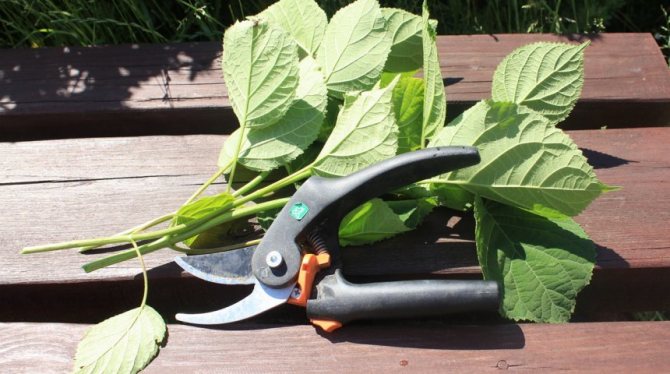

Hydrangea cuttings
In industrial floriculture, root green cuttings are usually used for propagation; they grow from plants placed in a greenhouse for distillation. Cuttings are cut at an angle with a knife, trying not to wrinkle the tissue fibers of the plant. Cuttings should be at least 6 cm and have 2-3 internodes, while 1 or 2 leaves are cut off at the lower node.
The youngest shoots take root better. Cut into a peat-sandy substrate (two to one). The cuttings are planted in the racks of the distribution greenhouse to a depth of one centimeter. The temperature should be maintained at least 18 and not higher than 20 C. After planting, they are thoroughly sprayed and the substrate is kept moist throughout the entire rooting period.


Rooting hydrangea cuttings in the substrate
Cuttings take root after 20-25 days in January and 15-20 days later in March-April. Rooted cuttings are planted in 7-9 cm pots with a mixture of peat or turf soil (1: 1) with a small addition of sand and 3 kg of horn shavings per one cubic meter of the mixture. The pots are kept at a temperature of 14-15 C, and in April they are transferred to semi-warm greenhouses and installed at 100 pieces per square meter. Hydrangea is grown for 1-3 stems or more. Early varieties, especially early grafting terms, are grown in 2-, 3-, sometimes 4-stem form. For 1-stem culture, I use late and early varieties, but late terms of cuttings.
An increase in the number of stems at later dates leads to a decrease in the size of the inflorescences. In June, the plants are transferred into pots with a diameter of 11-13 cm. After rooting (after a week), the plants are placed in open ground ridges in holes prepared in advance, 20-25 pieces per square meter. The top of the pot should be 3-4 cm above ground level. The soil in pots and between them is mulched with peat. Planting directly into the ridges without a pot is possible.


